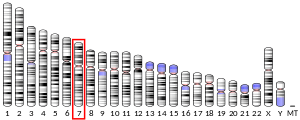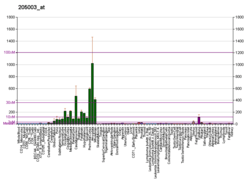Dock4
Dock4, (Dedicator of cytokinesis 4) also known as DOCK4, is a large (~190 kDa) protein involved in intracellular signalling networks.[5] It is a member of the DOCK-B subfamily of the DOCK family of guanine nucleotide exchange factors (GEFs) which function as activators of small G proteins. Dock4 activates the small G proteins Rac and Rap1.
Discovery
Dock4 was discovered as a gene product which was disrupted during tumour progression in a murine cancer model-derived osteosarcoma cell line.[6] Subsequent Northern blot analysis revealed high levels of Dock4 expression in skeletal muscle, prostate and ovary as well as lower levels in the heart, placenta and colon. A separate study has reported expression of a Dock4 splice variant (Dock4-Ex49) in the brain, inner ear and eye.[7]
Structure and function
Dock4 is part of a large class of proteins (GEFs) which contribute to cellular signalling events by activating small G proteins. In their resting state G proteins are bound to Guanosine diphosphate (GDP) and their activation requires the dissociation of GDP and binding of guanosine triphosphate (GTP). GEFs activate G proteins by promoting this nucleotide exchange.
The domain arrangement of Dock4 is largely equivalent to that of Dock180 (the archetypal member of the DOCK family) and other DOCK-A/B family members (35% sequence identity with Dock180, 39% with Dock2 and 54% with Dock3[6]). Dock4, however, contains a unique set of motifs at its proline-rich C-terminus which include a Src-binding site that is shared with CED-5, the C. elegans ortholog of mammalian DOCK proteins.[6] Dock4 also contains a DHR2 domain (also known as Docker2 or CZH2) which is conserved among DOCK family proteins and mediates GEF-dependent functions, and a DHR1 domain (CZH1/Docker1) which has been shown to bind PtdIns(3,4,5)P3,[8] an important step in recruitment to the plasma membrane.
Regulation of Dock4 activity
DOCK family proteins are inefficient at promoting nucleotide exchange on their own since they appear to adopt an autoinhibitory conformation in their resting state. The adaptor protein ELMO has been shown to bind DOCK proteins and induce a conformational change which relieves the inhibition and allows G proteins access to the DHR2 domain.[9] Binding to ELMO requires the atypical PH domain of ELMO and also involves an interaction between the N-terminal SH3 domain of DOCK and a proline-rich motif at the ELMO C-terminus.[10] ELMO also binds the activated form of the small G protein RhoG and this has been shown to promote DOCK-dependent signalling by helping recruit the ELMO-DOCK complex to areas of high substrate availability (usually the plasma membrane).[11] The C-terminus of DOCK proteins interacts with another adaptor protein, Crk.[12][13] Dock4 undergoes RhoG/ELMO-dependent recruitment to the plasma membrane and promotes migration in fibroblasts.[14] In rat hippocampal neurones Dock4 forms a trimeric complex with ELMO2 and CrkII which is required for the normal development of dendrites.[15] More recently, a role has been described for Dock4 as part of the Wnt signalling pathway which regulates cell proliferation and migration. In this system Dock4 was reported to undergo phosphorylation by Glycogen synthase kinase 3 (GSK-3) which stimulated an increase in Dock4 GEF activity.[16]
Signalling downstream of Dock4
DOCK family proteins contribute to cell signalling by activating G proteins of the Rho family, such as Rac and Cdc42.[17] Dock4 has also been shown to activate Rap1,[6] a feature not reported in any of the other DOCK family proteins to date. Dock4 dependent Rac activation regulates reorganisation of the cytoskeleton and leads to the formation of membrane protrusions (e.g. lamellipodia) which are a crucial step in neuronal development and cell migration.[14][15] The effect of Dock4 on the Wnt pathway appears to be mediated through Rac activation as well as through GEF-independent associations with components of the "β-catenin degradation complex".[16]
Dock4 in cancer
Mutations in Dock4 have been described in a number of cancers.[6][18][19] The exact mechanism and extent to which it regulates cancer-associated signalling pathways is poorly understood thus far although a mutation in Dock4 which affects its GEF specificity has been reported to promote detachment and invasion of cancer cells.[6]
References
- GRCh38: Ensembl release 89: ENSG00000128512 - Ensembl, May 2017
- GRCm38: Ensembl release 89: ENSMUSG00000035954 - Ensembl, May 2017
- "Human PubMed Reference:". National Center for Biotechnology Information, U.S. National Library of Medicine.
- "Mouse PubMed Reference:". National Center for Biotechnology Information, U.S. National Library of Medicine.
- "Entrez Gene: DOCK4 dedicator of cytokinesis 4".
- Yajnik V, Paulding C, Sordella R, et al. (March 2003). "DOCK4, a GTPase activator, is disrupted during tumorigenesis". Cell. 112 (5): 673–684. doi:10.1016/S0092-8674(03)00155-7. PMID 12628187.
- Yan D, Li F, Hall ML, et al. (March 2006). "An isoform of GTPase regulator DOCK4 localizes to the stereocilia in the inner ear and binds to harmonin (USH1C)". Journal of Molecular Biology. 357 (3): 755–764. doi:10.1016/j.jmb.2006.01.017. PMID 16464467.
- Kanai A, Ihara S, Ohdaira T, et al. (July 2008). "Identification of DOCK4 and its splicing variant as PIP3 binding proteins". IUBMB Life. 60 (7): 467–472. doi:10.1002/iub.67. PMID 18459162.
- Lu M, Kinchen JM, Rossman KL, et al. (February 2005). "A Steric-inhibition model for regulation of nucleotide exchange via the Dock180 family of GEFs". Current Biology. 15 (4): 371–377. doi:10.1016/j.cub.2005.01.050. PMID 15723800.
- Komander D, Patel M, Laurin M, et al. (September 2008). "An Alpha-Helical Extension of the ELMO1 Pleckstrin Homology Domain Mediates Direct Interaction to DOCK180 and Is Critical in Rac Signaling". Molecular Biology of the Cell. 19 (11): 4837–4851. doi:10.1091/mbc.E08-04-0345. PMC 2575150. PMID 18768751.
- Katoh H, Negishi M (July 2003). "RhoG activates Rac1 by direct interaction with the Dock180-binding protein Elmo". Nature. 424 (6947): 461–464. doi:10.1038/nature01817. PMID 12879077.
- Hasegawa H, Kiyokawa E, Tanaka S, et al. (April 1996). "DOCK180, a major CRK-binding protein, alters cell morphology upon translocation to the cell membrane". Molecular and Cellular Biology. 16 (4): 1770–1776. doi:10.1128/mcb.16.4.1770. PMC 231163. PMID 8657152.
- Akakura S, Kar B, Singh S, et al. (July 2005). "C-terminal SH3 domain of CrkII regulates the assembly and function of the DOCK180/ELMO Rac-GEF". Journal of Cellular Physiology. 204 (1): 344–351. doi:10.1002/jcp.20288. PMID 15700267.
- Hiramoto K, Negishi M, Katoh H (December 2006). "Dock4 is regulated by RhoG and promotes Rac-dependent cell migration". Experimental Cell Research. 312 (20): 4205–4216. doi:10.1016/j.yexcr.2006.09.006. PMID 17027967.
- Ueda S, Fujimoto S, Hiramoto K, et al. (July 2008). "Dock4 regulates dendritic development in hippocampal neurons". Journal of Neuroscience Research. 86 (14): 3052–3061. doi:10.1002/jnr.21763. PMID 18615735.
- Upadhyay G, Goessling W, North TE, et al. (July 2008). "Molecular association between beta-catenin degradation complex and Rac guanine exchange factor DOCK4 is essential for Wnt/beta-catenin signaling". Oncogene. 27 (44): 5845–5855. doi:10.1038/onc.2008.202. PMC 4774646. PMID 18641688.
- Côté JF, Vuori K (December 2002). "Identification of an evolutionarily conserved superfamily of DOCK180-related proteins with guanine nucleotide exchange activity". Journal of Cell Science. 115 (Pt 24): 4901–4913. doi:10.1242/jcs.00219. PMID 12432077.
- Okamoto OK, Carvalho AC, Marti LC, et al. (June 2007). "Common molecular pathways involved in human CD133+/CD34+ progenitor cell expansion and cancer". Cancer Cell International. 7: 11. doi:10.1186/1475-2867-7-11. PMC 1904434. PMID 17559657.
- Liang H, Castro PD, Ma J, Nagarajan L (October 2005). "Finer delineation and transcript map of the 7q31 locus deleted in myeloid neoplasms". Cancer Genetics and Cytogenetics. 162 (2): 151–159. doi:10.1016/j.cancergencyto.2005.03.019. PMID 16213364.
Further reading
- Côté JF, Vuori K (2007). "GEF what? Dock180 and related proteins help Rac to polarize cells in new ways". Trends in Cell Biology. 17 (8): 383–393. doi:10.1016/j.tcb.2007.05.001. PMC 2887429. PMID 17765544.
- Côté JF, Vuori K (2006). "In vitro guanine nucleotide exchange activity of DHR-2/DOCKER/CZH2 domains". Methods in Enzymology. 406: 41–57. doi:10.1016/S0076-6879(06)06004-6. PMID 16472648.
- Meller N, Merlot S, Guda C (2005). "CZH proteins: a new family of Rho-GEFs". Journal of Cell Science. 118 (Pt 21): 4937–4946. doi:10.1242/jcs.02671. PMID 16254241.
- Hillier LW, Fulton RS, Fulton LA, et al. (2003). "The DNA sequence of human chromosome 7". Nature. 424 (6945): 157–164. doi:10.1038/nature01782. PMID 12853948.
- Kimura K, Wakamatsu A, Suzuki Y, et al. (2006). "Diversification of transcriptional modulation: large-scale identification and characterization of putative alternative promoters of human genes". Genome Research. 16 (1): 55–65. doi:10.1101/gr.4039406. PMC 1356129. PMID 16344560.




